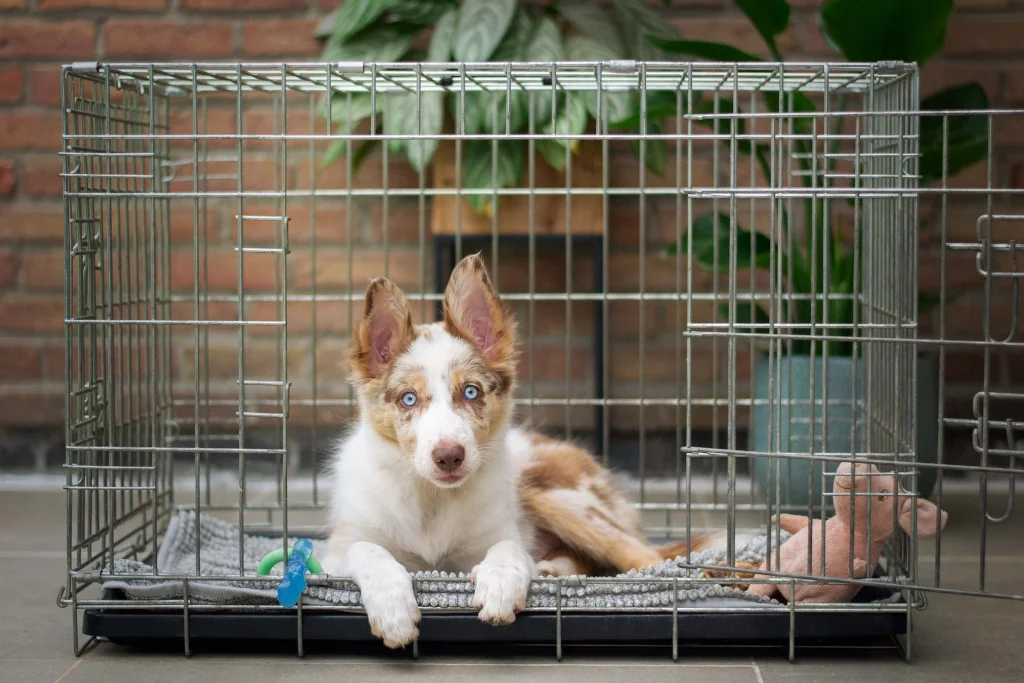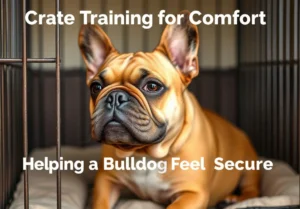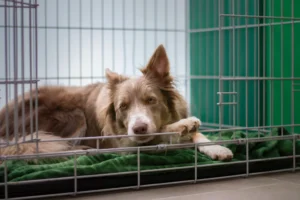Disclosure: We may earn a commission from helpful, relevant links in our content. No cost to you. See our privacy policy.
Finding the perfect dog crate isn’t as straightforward as you’d think, is it? Navigating the sea of sizes, materials, and styles can leave you dizzy.
That feeling of uncertainty as you click “add to cart,” not knowing if your pooch will feel safe or cramped, is more than a little stressful.
What’s more, when we factor in the essential role the crate plays in your furry friend’s life – their personal den, safe space, and transport pod – the stakes climb even higher. Relax, take a deep breath; we’re here to guide you through this.
By the end of this post, you’ll be able to confidently select the right crate for your canine companion.

Key Features to Look for in a Dog Crate
Selecting a dog crate isn’t just about size. Several key features contribute to the crate’s safety, comfort, and usability, both for you and your pet.
- First, look for sturdy construction. The crate should be robust and durable enough to withstand your dog’s weight and strength. Whether it’s made from plastic, wire, or fabric, the material should hold up to your dog’s natural behavior.
- Second, pay attention to the door mechanism. It needs to be secure to prevent your Houdini hound from making an impromptu escape but simple enough for you to operate even with your hands full.
- Lastly, consider the crate’s ease of cleaning. Dogs, especially puppies, can be messy. A crate with a removable tray or washable fabric can save you from unpleasant cleaning duties down the line.
An ideal crate isn’t just about its practical aspects – it’s also about creating a cozy den where your furry buddy can feel safe and at home. So, let’s dive deeper and guide you towards finding that perfect fit!
Finding the Right Size Crate for Your Dog
Getting the right size crate for your dog is crucial. You want to make sure the crate is just spacious enough for your furry friend to stand up, turn around, and lie down comfortably.
Too small, and your pet may feel cramped and anxious. Too large, and it may not provide the feeling of security that dogs crave.
Here’s a simple guideline to follow:
- Measure your dog from the tip of their nose to the base of their tail. Add four inches to this number.
- Measure your dog from the top of their head to the ground. Again, add four inches.
If you have a puppy, account for their expected adult size, or look for a crate with a divider that you can adjust as they grow.
Our Top Picks for Dog Crates
Now, let’s move on to some recommendations:
- MidWest iCrate Single Door & Double Door Folding Metal Dog Crates: These crates come in a wide range of sizes, from 18 inches to 48 inches. They feature a sturdy metal construction and include a divider panel – perfect for growing puppies.

- AmazonBasics Single Door & Double Door Folding Metal Crate: This is another great option available in multiple sizes. The double-door design provides convenience, and it also includes a removable plastic pan for easy cleaning.

- Frisco Fold & Carry Single Door Collapsible Wire Dog Crate: This option is easy to set up and take down, making it great for pet parents on the go. It comes in sizes from 22 inches to 48 inches and includes a divider and a removable tray.

Remember, the goal is not just to contain your dog but to provide a safe and cozy space for them. Choosing the right size crate is a giant leap towards that direction.
Which Type of Dog Crate to Choose?
Choosing the type of crate for your dog largely depends on your dog’s personality, your lifestyle, and your aesthetic preferences. Here’s a rundown of the most common types and our top picks in each category:
Wire Crates
These are versatile, ventilated, and allow your dog to see their surroundings. They’re easy to clean and often collapsible for transport. The drawback? Some dogs might feel exposed, and the aesthetic might not suit everyone’s home decor.

For those who prioritize practicality and function, our top pick is the MidWest Life Stages Double Door Folding Dog Crate. It’s sturdy, easy to assemble, and comes with a divider, perfect for growing pups.
Plastic Crates
These are often the go-to for air travel and are typically cozier and offer more privacy than wire crates. However, they’re not as easy to clean and offer less ventilation.

For frequent travelers or dogs who appreciate a bit more seclusion, we recommend the Petmate Sky Kennel. It’s durable, secure, and meets most airline cargo specifications.
Furniture-style Crates
These crates are designed to blend with your home decor and often double as a side table. They’re usually made of wood or a similar material. While they win in aesthetics, they may not be the best choice for puppies or dogs who like to chew.

One of our favorite furniture-style crates is the Crown Pet Products Wood Pet Crate End Table. It’s attractive, well ventilated, and offers a comfy spot for your dog to relax.
Soft-sided Crates
Lightweight and portable, these are perfect for trips to the park, camping, or any place where you need a temporary, lightweight containment solution.

We love the EliteField 3-Door Folding Soft Dog Crate for its durability, multiple doors, and the included accessory pockets.
Here’s a comparison table for the types of crates:
| Type of Crate | Pros | Cons |
|---|---|---|
| Wire Crates | Ventilated, versatile, easy to clean, collapsible for transport | Some dogs may feel exposed; might not suit all decor |
| Plastic Crates | Ideal for air travel, cozier, more private | Harder to clean, less ventilation |
| Furniture-style Crates | Blends with home decor, can double as a table | May not suit dogs who like to chew; not ideal for puppies |
| Soft-sided Crates | Lightweight, portable, perfect for temporary containment | Less durable; not for long-term, everyday use |
Ultimately, the type of crate you choose should align with your dog’s needs and your lifestyle. No single crate is perfect for every dog, but with a bit of thought, you can find the perfect fit for your four-legged friend.
Where to Place Your Dog’s Crate in Your Home?
Choosing where to put your dog’s crate is just as essential as deciding on the crate itself.
Dogs are social animals; they want to feel included, not isolated, and the crate’s location can significantly impact your dog’s acceptance of it.
Let me share a quick story: I remember how Sam, my ever-so-curious buddy, initially refused to use the crate I set up for him. I placed it in a little-used spare room, thinking he’d appreciate the quiet. I couldn’t have been more wrong.
Sam wanted to be where the action was. So, I moved the crate to the living room, near the couch where we would watch TV. The transformation was dramatic. Sam now had a front-row seat to the family’s daily activities, and he started using the crate willingly. That’s the power of the right placement.
So, consider putting your dog’s crate in a family area like the living room, kitchen, or bedroom if your dog sleeps with you. Choose a spot that’s out of heavy foot traffic but where your dog can still see and hear you.
Avoid placing the crate near a heat source, drafty areas, or direct sunlight. A quiet corner with a view of the room is often a good choice.
Here are some essential crate placement Dos and Don’ts:
- Do place the crate in a family area.
- Don’t put it in a rarely used room.
- Do consider your dog’s personality when choosing the spot.
- Don’t place the crate near a heat source, drafty areas, or direct sunlight.
- Do experiment with different spots until you find their perfect ‘crate spot’.
What worked for Sam might not work for all, but it’s a good starting point. Consider your dog’s personality and experiment with different spots until you find their perfect ‘crate spot’.
Once you placed your crate, it’s time to crate-train your dog. There are many benefits to crate training. To get started with crate training your dog, follow this guide.
FAQs
Should I buy a larger crate for my puppy to grow into?
A larger crate may encourage a puppy to use part as a bathroom. It’s better to buy a crate that fits your puppy’s current size, or use a divider that can be adjusted as they grow.
Can the crate be moved from room to room?
Moving the crate frequently may disrupt your dog’s sense of security. It’s best to keep it in a consistent location, ensuring that if it’s moved, the new spot also feels safe and comfortable.
Can I use a crate for traveling with my dog?
Crates can be used for travel, particularly by car or plane. However, it should be well-ventilated, secure, and comply with specific travel requirements, like airline regulations.
What kind of bedding should I put in my dog’s crate?
Use comfortable, safe bedding like a machine-washable crate pad or a durable dog bed. Avoid materials that your dog might chew and ingest. Always monitor your dog with their bedding for safety.
Alex, a passionate animal lover, has experience in training and understanding animal behavior. As a proud pet parent to two dogs and three cats, he founded AnimalReport.net to share insights from animal experts and expand his knowledge of the animal kingdom.




